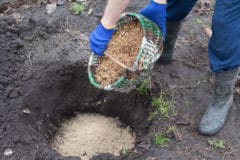What Blueberries Need
Providing your blueberries with optimal conditions will keep them disease free. The following list details the requirements for growing blueberries that produce high yields of berries:
- Soil requirements – Well-drained, acidic soil with a pH of 4.5 to 5.6., and high organic matter
- Water – 1 to 2 inches of water every week, being careful not to water-log the roots.
- Cover crops – Planting cover crops reduces pathogens and controls weeds. These crops include buckwheat, sorghum, millet and rapeseed.
- Mulch – Apply 4 to 6 inches of mulch with a cover layer of pine bark, peat moss or sawdust compost
- Nitrogen – Test the soil and add nitrogen each year, if necessary.
- Prune – Prune any dead or damaged canes while the blueberries are dormant. This allows for air circulation to prevent fungus growth.
Blueberry Diseases
If you gave your blueberry bushes the proper requirements, you probably won’t have to worry about them becoming infected, but sometimes it can happen. These are the most common diseases that blueberries contract:
Fungal Fruit Rots
These are the major fungal fruit rots of blueberries and their symptoms. Once these diseases infect your blueberries, they’re very difficult to eradicate:
- Ripe rot or Anthracnose – The fungus (Colletotrichum acutatum) causes this disease. Its spores infect the green berries, which begin rotting when they start to ripen. The sticky, orange fungus continues to invade the berries even after harvest.
- Botrytis blight or gray mold – Cool, wet weather causes gray mold (Botrytis cinerea) to grow on blueberry bushes. The blight overwinters on dead or decomposing plants that are covering the soil. It results in blossom blight, fruit rot and dying green branches.
- Mummy berry – This fungus (Monilinia vaccinia-corymbosi) creates infected flowers that attract bees. The bees carry the fungal spores to other flowers as they collect pollen, infecting more of the plant. The diseased flowers produce berries filled with the fungus. The pink berries fall to the ground, infecting the soil. The fungus then infects young plant shoots.
Bacterial Diseases
Bacterial diseases are devastating to blueberry bushes. Pruning all the dead and diseased branches helps manage these diseases, but sometimes replacing the bushes is the only solution.
- Bacterial canker – The bacterium (Pseudomonas syringae) causes this blueberry disease. The succulent young branches of newly planted blueberries are prime candidates for this bacterial canker. The disease enters the plant in the spring through damaged areas caused by frost. Prune any damaged branches immediately.
- Crown gall – This disease (Agrobacterium tumefaciens) lives in the soil. It infects damaged stems and roots, resulting in the formation of knobby galls. Rain, water, infected garden tools and cuttings spread the disease to other blueberry plants. If any of your blueberries grow galls, pull them up. You have to wait three years before planting in the infected area again.
Many other blueberry diseases caused by fungus, bacteria, viruses and nemotodes can infect your plants. Remember that you can prevent most of these diseases with proper care and maintenance.












